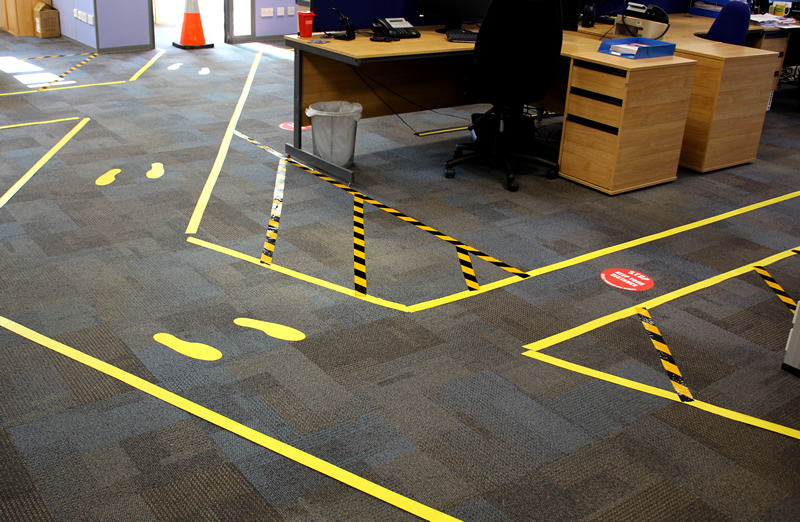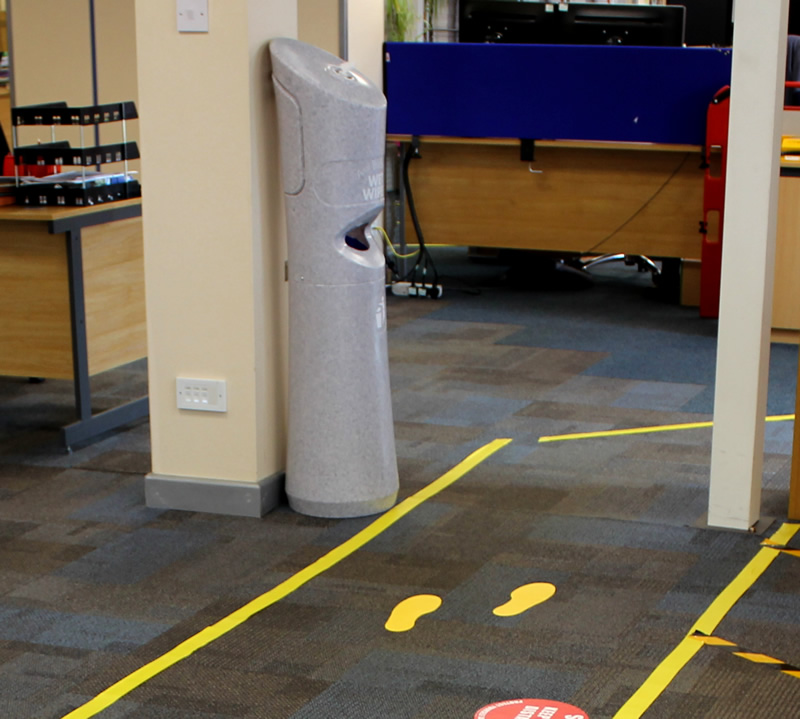How to help make your office Covid-safe
The Government recently announced the implementation of 'Plan B' in the fight against Covid, with the requirement for people to work from home if they can. If that’s not possible for your business and you need to have staff in the office, then you will want to ensure they are kept as safe as possible.
We first published some guidance back in November 2020 on how to make your office Covid-safe for staff to return, and have now re-visited the tips and ideas. With some careful thought and attention, by making signage clear and giving everyone clear and unambiguous instructions it should be possible to ensure your staff can all work safely in the office:
Entrances
Make it clear on your main entrance how you would like staff and visitors to behave. Would you like them to ring a doorbell to be let in, or is there somewhere inside they can stand? On first entry, it is important that people use hand sanitiser. This can be self-administered from a hands free dispenser after touching the outside door handle and before touching anything else. It may be advisable to install a non-contact infrared thermometer, enabling staff and visitors to check they don’t have an increased temperature before entering the office.
Layout
Desks should ideally be spaced at least a metre apart and rotated so that people do not sit face-to-face. Bear in mind that people will also need adequate access to their work area, ideally not in a way that brings them too close to other's workspaces. Common walkways should pass behind worker’s backs, spaced a metre away. Where possible, offices should have a one-way system to avoid people passing each other and if you have the ability, a separate entrance and exit. Where crossings and busy pinch points occur, there should be clear stop signs and instructions on where to give way to.

Marking Out
Outdoors, you have the option of line marking spray paint or tape. Indoors, in most cases, tape is going to be the easiest way. Floor tape is easy to apply and should be laid out in a pathway at least a metre wide. Staff can be directed where to go by using feet graphics or arrows, if you are able to implement a one-way system, make sure it is obvious which way you should go. If you are unable to accommodate one-way, you should make sure there are safe passing points which allow the avoidance of people coming the other way. Blind corners should be equipped with viewing mirrors to stop collisions and make distancing easier. Note that floor tape will stick to short pile carpet or hard flooring, but the tape will shrink back over time, as the tension on the tape causes it to retract. This can be avoided by not stretching the tape too tight when applying to the floor.
Where staff need to approach each other’s desks, it is useful to mark a spot at least a metre away, so they can stand on this and interact. Colleagues should be encouraged to communicate via email where possible.
The movement of tables often causes issues with cables. Where desks are more spaced out and it causes trailing wires, remember to install cable covers and tidies to keep leads together and prevent trip hazards.
It is also worth looking at how you can block up short cuts, to prevent people nipping through gaps in desks and not following your path. Temporary expanding barriers, cones and office partitions are all good for this purpose.
Hygiene
Having the office cleaned on a regular basis is obviously of vital importance to improve hygiene and reduce risk. You may also want to consider 'fogging' This is a process that uses disinfectant sprayed from a fogging machine and can be effective at disinfecting hard to reach areas.
Offices should be providing staff with anti-bacterial wipes for their desks and be routinely cleaning common touch points such as door handles and light switches. Other ideas to limit the spread of germs are foot operated door pulls and motion sensor lighting.

It is also important manage incoming mail. Personal deliveries to the office should be minimised and any work related post should be left in a reception area and hands should be washed after handling it.
Communal areas
Kitchens and toilets can be particularly difficult to manage. Staggered lunchtimes will help to reduce the need for everyone to use facilities at the same time, and positioning tables and seating a good distance apart will encourage people to socially distance.
If meetings cannot be held virtually, then they should be kept to a minimum length and with as few people attending as possible and consider installing PVC screens to minimise the spread of germs via coughs and sneezes.
Printers, shredders and other shared devices should be away from desks and have adequate space around them to allow queuing.
With some planning and correct equipment, your office can be made as Covid-secure as possible, allowing your employees to feel safe in their working environments.
Featured images have been taken in the ESE Direct office in Norwich, using products available on our site. You can browse our range at www.esedirect.co.uk or call us to talk about your requirements on 0800 161 3436.

Author Bio - Martin Gilmour
Marketing Manager for ESE Direct, in my spare time I enjoy reading, playing music and near-total avoidance of DIY.





